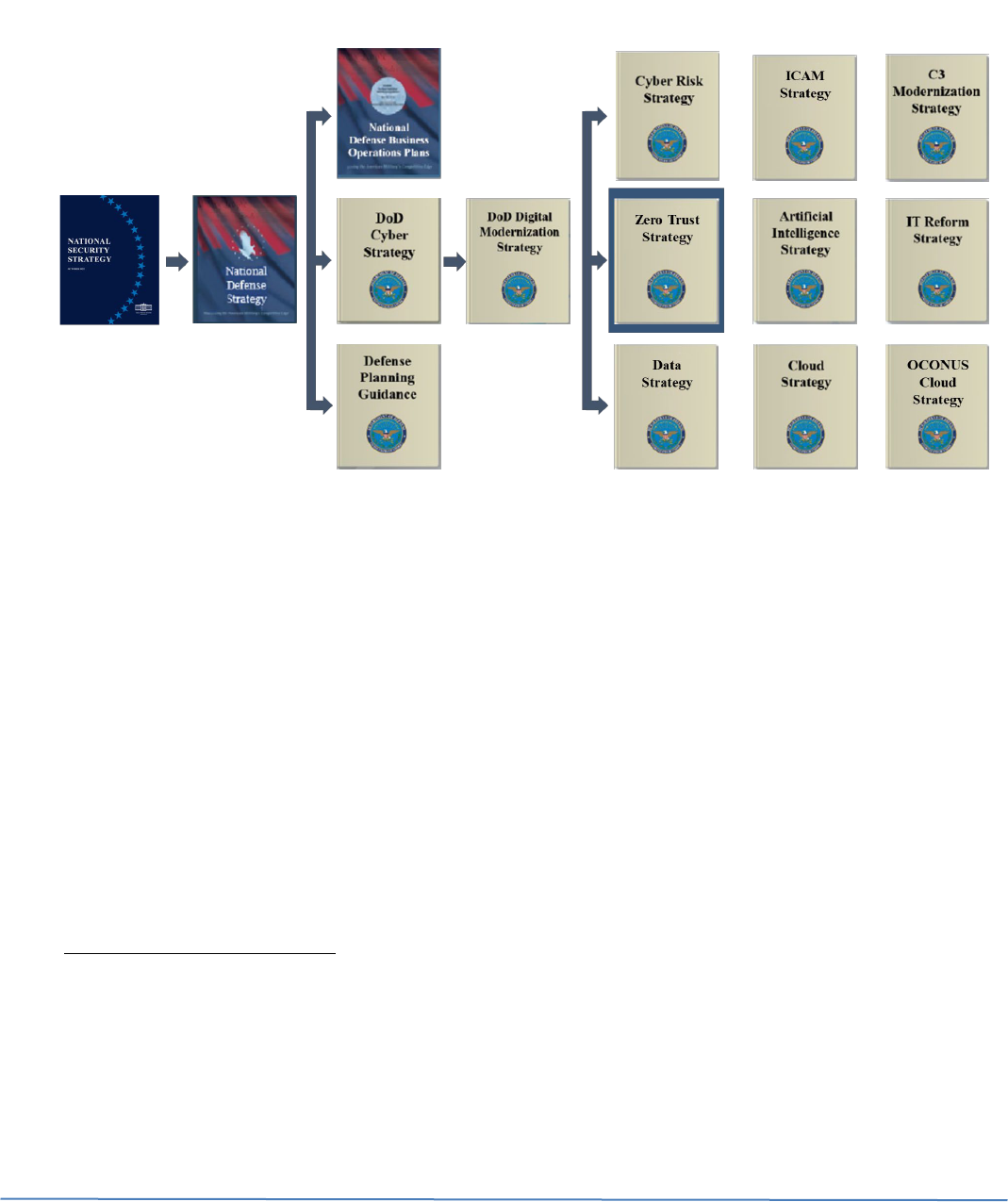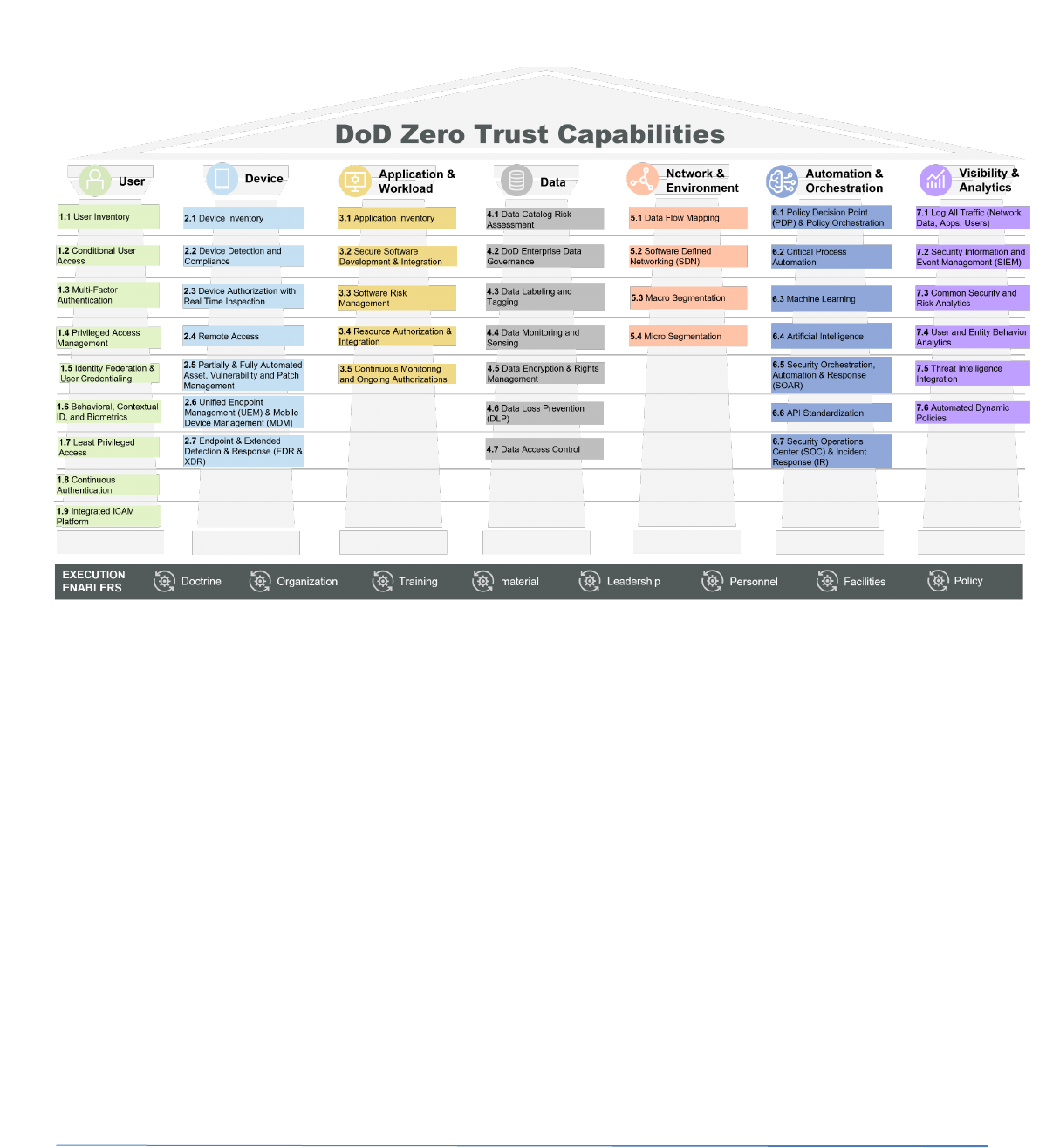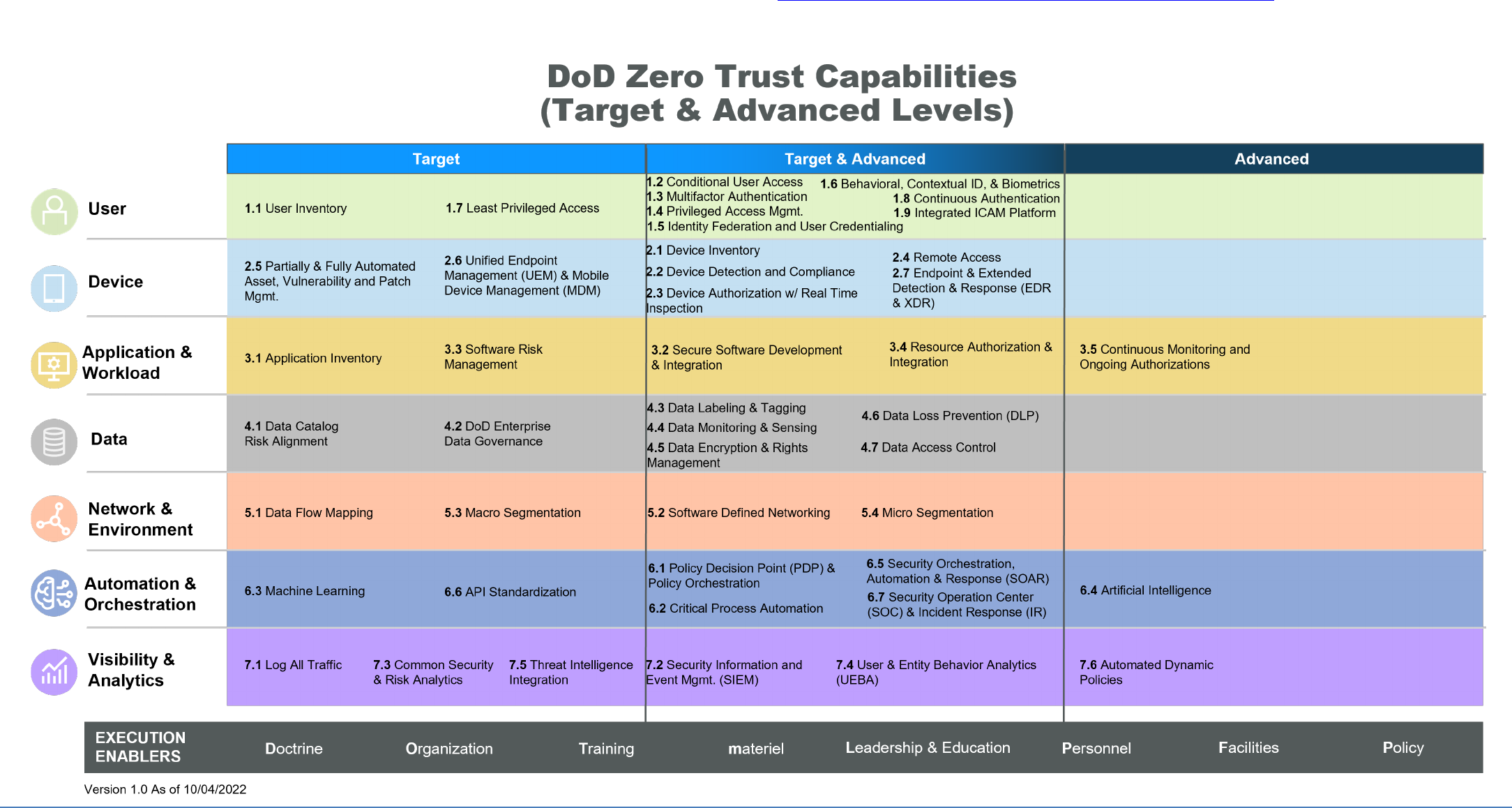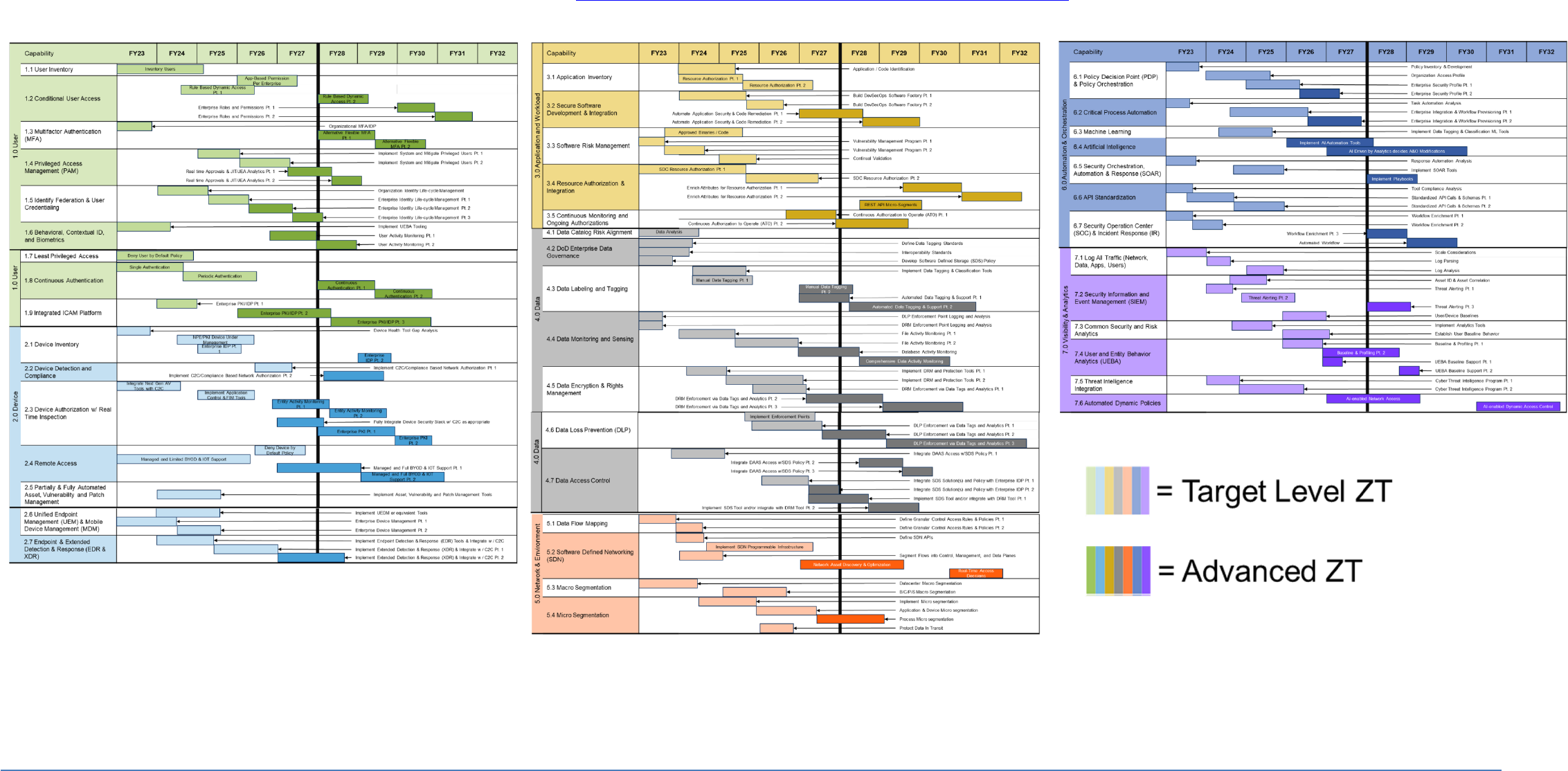
UNCLASSIFIED//FOR.OFFICIAL USE.ONLY
Pre-Decisional Draft
. .
. .
!
Pre-Decisional Draft
UNCLASSIFIED//FOR.OFFICIAL USE.ONLY
Version 1.0
Zero Trust CONOPS
d
October 21, 2022
CLEARED
For Open Publication
Department of Defense
OFFICE OF PREPUBLICATION AND SECURITY REVIEW
Nov 07, 2022

i
DoD Zero Trust Strategy
Prepared by: ZT PfMO
Change History
Version
Date
Page(s) Changed
Comments
1.0 10/21/2022 Initial published version
October 21, 2022

ii
DoD Zero Trust Strategy
Foreword
Our adversaries are in our networks, exfiltrating our data, and exploiting the Department’s users.
The rapid growth of these offensive threats emphasizes the need for the Department of Defense
(DoD) to adapt and significantly improve our deterrence strategies and cybersecurity
implementations. Defending DoD networks with high-powered and ever-more sophisticated
perimeter defenses is no longer sufficient for achieving cyber resiliency and securing our information
enterprise that spans geographic borders, interfaces with external partners, and support to millions of
authorized users, many of which now require access to DoD networks outside traditional boundaries,
such as work from home. To meet these challenges, t
he DoD requires an enhanced cybersecurity
framework built upon Zero Trust principles that must be adopt
ed
across the Department,
enterprise-wide, as quickly as possible as described within this document.
This urgency means that
our colleagues, our warfighters, and every member of DoD must adopt
a Zero Trust mindset, regardless of whether they work in technology or cybersecurity or the
Human Resource department. This “never trust, always verify” mindset requires us to take
responsibility for the security of our devices, applications, assets, and services; users are granted
access to only the data they need and when needed. We all must play a role in combating our
adversaries by acting quickly and correctly to address security threats wherever and whenever
they arise.
Zero Trust is m
uch more than an IT solution. Zero Trust may include certain products but is not
a capability or device that may be bought. The journey to Zero Trust requires all DoD
Components to adopt and integrate Zero Trust capabilities, technologies, solutions, and
processes across their architectures, systems, and within their budget and execution plans.
Perhaps most importantly, they must also address Zero Trust requirements within their staffing,
training, and professional development processes as well.
This Zero Trust
strategy, the first of its kind for the Department, provides the necessary
guidance for advancing Zero Trust concept development; gap analysis, requirements
development, implementation, execution decision-making, and ultimately procurement and
deployment of required ZT capabilities and activities which will have meaningful and
measurable cybersecurity impacts upon adversaries. Importantly, this document serves only as a
strategy, not a solution architecture. Zero Trust Solution Architectures can and should be
designed and guided by the details found within this document.
In January 202
2, the Department established the DoD Zero Trust Portfolio Management Office
(ZT PfMO) within the DoD CIO, to orchestrate the DoD efforts outlined in this
DoD Zero Trust
Strategy
document and to accelerate ZT adoption through several courses of action.
Recognizing
that the starting point for Zero Trust and maturity levels varies between components, Components
October 21, 2022

DoD Zero Trt Strate
ll1
October 21, 2022

iv
DoD Zero Trust Strategy
Executive Summary
"Incremental improvements will not give us the security we need; instead, the
Federal Government needs to make bold changes and significant investments in
order to defend the vital institutions that underpin the American way of life."
— Executive Order on Improving the Nation’s Cybersecurity 12 May 2021
Five Years into the Future
The Department of Defense's (DoD) risk-based Zero Trust Framework employed across the Joint
Force and the defense ecosystem protects our information systems
1
from increasingly sophisticated
attacks as our adversaries seek to affect our warfighters and DoD mission success. Zero Trust
principles are now integrated into each of the five cybersecurity functions that represent key elements
of a successful and holistic cybersecurity program – Identify, Protect, Detect, Respond, and
Recover.
2
As a result, DoD will successfully mitigate attempts to deny, degrade, disrupt, deceive, or
destroy our information systems. Operators at all levels are confident that the data accessed, the
assets deployed, the applications used, and the services provided are secured and resilient.
Today
The Department's Information Enterprise is under wide scale and persistent attack from known and
unknown malicious actors. The Department’s most consequential strategic competitor and the pacing
challenge for the Department, the People’s Republic of China,
3
as well as other state-sponsored
adversaries and individual malicious actors often breach the Department’s defensive perimeter and
roam freely within our information systems. The Department must act now.
Vulnerabilities exposed by data breaches inside and outside the Department of Defense demonstrate
the need for a new, more robust cybersecurity framework that facilitates well-informed risk-based
decisions.
4
Zero Trust security eliminates the traditional idea of perimeters, trusted networks,
devices, personas, or processes and shifts to multi-attribute-based levels of confidence that enable
authentication and authorization policies founded on the concept of least privileged access.
Implementing the Zero Trust Framework requires designing a more efficient architecture that
enhances security, the user experience, and overall mission performance.
Zero Trust uses continuous multi-factor authentication, micro-segmentation, advanced encryption,
endpoint security, analytics, and robust auditing, among other capabilities, to fortify data,
1
Information system includes “a discrete set of information resources organized for the collection, processing,
maintenance, use, sharing, dissemination, or disposition of information”. See DoD Instruction (DoDI) 5000.82,
Acquisition of Information Technology (IT), 21 Apr 2020, p. 17.
2
See US National Institute of Standards and Technology (NIST), Special Publication 1271, Getting Started with the
NIST Cybersecurity Framework: A Quick Start Guide, 6 August 2021, for descriptions of cybersecurity core
functions and a set of guidelines for mitigating organizational cybersecurity risks.
3
Fact Sheet: 2022 National Defense Strategy, 28 March 2022.
4
Risk” refers to probability of an undesired event or condition and 2) the consequences, impact, or severity of the
undesired event, were it to occur. See DoD Risk, Issue, and Opportunity Management Guide for Defense Acquisition
Programs, January 2017, p. 3
October 21, 2022

v
DoD Zero Trust Strategy
applications, assets, and services to deliver cyber resiliency. The Department is evolving to become a
more agile, more mobile, cloud-supported workforce, collaborating with the entirety of DoD
enterprise, including federal and non-federal organizations and mission partners working on a variety
of missions. The Zero Trust Framework will reduce the attack surface, reduce risk, offer
opportunities to manage the full range of risks (e.g., policy, programming, budgeting, execution,
cybersecurity-specific, and others) and enable more effective data-sharing in partnership
environments. It will also ensure that any adversary damage is quickly contained and remediated if a
device, network, user, or credential is compromised.
This strategy lays out the Department's vision for Zero Trust and sets a path to achieve it. It includes
the strategic assumptions and principles that will inform and guide the adoption of ZT and the
strategic goals and objectives. The four strategic goals outlined in this strategy are: 1. Zero Trust
Culture Adoption, 2. DoD Information Systems Secured and Defended, 3. Technology Acceleration,
and 4. Zero Trust Enablement. The strategy also refers to the seven DoD Zero Trust Pillars, which is
the basis for the strategy's Zero Trust Capability Roadmap, a capabilities-based execution plan, and
the DoD Zero Trust and Cybersecurity Reference Architectures. Finally, this strategy provides high-
level guidance on resourcing and acquisition, measurement and metrics, and governance. The
appendices include strategic and execution milestones, as well as references and definitions.
To accelerate Zero Trust implementation within the DoD Information Enterprise, the Department
must continue to examine how to streamline and enforce resource priorities to meet the requirements
envisioned by this strategy. In January 2022, the DoD CIO established a Zero Trust Portfolio
Management Office (PfMO) to orchestrate DoD-wide Zero Trust execution, simplify and streamline
existing policies and coordinate the prioritization of resources to accelerate Zero Trust adoption
within the DODIN enterprise.
Figure 1
below depicts a concise view of the vision, goals, and objectives the Department will
achieve by implementing the strategy.
5
5
See Figure 4 in this document for an outcome description of each goal and objective.
October 21, 2022

vi
DoD Zero Trust Strategy
Figure 1. DoD Zero Trust Strategy-at-a-Glance
October 21, 2022

vii
DoD Zero Trust Strategy
Contents
Executive Summary ............................................................................................................................ iv
Introduction .......................................................................................................................................... 1
Vision ..................................................................................................................................................... 4
DoD Zero Trust Approach .................................................................................................................. 7
Strategic Assumptions ......................................................................................................................... 7
Strategic Goals and Objectives ......................................................................................................... 11
Execution Approach .......................................................................................................................... 14
Summary ............................................................................................................................................. 21
APPENDIX A: DoD Zero Trust Capabilities (Target & Advanced Levels) ................................ 22
APPENDIX B: DoD Zero Trust Activities (Target & Advanced Levels) ..................................... 23
APPENDIX C: DoD Zero Trust Capability Roadmap (by Fiscal Year) ...................................... 24
APPENDIX D: DoD Zero Trust Strategic and Execution Milestones (FY2023 – FY2024) ........ 25
APPENDIX E: References ................................................................................................................ 26
APPENDIX F: Acronyms / Definitions ............................................................................................ 28
October 21, 2022

1
DoD Zero Trust Strategy
Introduction
This Zero Trust Strategy defines an adaptive approach for how DoD must champion and accelerate
the shift to a Zero Trust architecture and framework that secures and protects DoD Information
Enterprise (IE)
6
within the Joint Information Environment (JIE)
7
and specifically the DoD
Information Network (DODIN).
8
The intent of the strategy is to establish the parameters and target
levels necessary to achieve Zero Trust (ZT) adoption across systems and networks (e.g., Non-
classified Internet Protocol Router Network (NIPRNet) and Secret Internet Protocol Router Network
(SIPRNet)).
This approach emphasizes the need for DoD and its Components
9
to embrace
evolving technology while adapting and responding to known and unknown malicious actors. It
involves the full breadth of stakeholders in the DoD ZT Ecosystem
10
and allows strategic
implementation to begin immediately.
Zero Trust is the te
rm for an “evolving set of cybersecurity paradigms that move defenses from static,
network-based perimeters to focus on users, assets, and resources."
11
At its core, ZT assumes no
implicit trust is granted to assets or users based solely on their physical or network location (i.e.,
local area networks versus the Internet) or asset ownership (enterprise or personally owned).
12
This
shift in philosophy is a significant change in legacy authentication and security mechanisms. It also
represents a major cultural change that stakeholders throughout the DoD ZT Ecosystem, including
the Defense Industrial Base (DIB), will need to embrace and execute beginning with FY2023 through
FY2027 and in the future.
6
DoD Directive (DoDD) 8000.01, Chg 1; Management of the Department of Defense Information Enterprise (DoD
IE), Section 3(d), 17 July 2017, defines the DoD IE to include: “the DoD information network infrastructure, DoD
enterprise IT service and solutions, National Security Systems, Industrial Control Systems, and
embedded computing of wired, wireless, mobile communication, and platforms.”
7
DoD Digital Modernization Strategy, 5 June 2019, pp. 35 -36 defines the Joint Information Environment (JIE) as
“a framework comprising a set of discrete initiatives developed and delivered as funded to support continual,
comprehensive Department-wide IT Modernization and advance DoD information superiority in a common,
coordinated way.” It also notes “the JIE also includes deployed tactical components that are designed to work with
core infrastructure and also operate autonomously, should connectivity to the core JIE be lost or denied.”
8
Joint Publication 6-0 Joint Communications System, 10 June 2015, Incorporating Change 1, 04 October 2019,
defines DODIN as “The set of information capabilities and associated processes for collecting, processing, storing,
disseminating, and managing information on demand to warfighters, policy makers, and support personnel, whether
interconnected or stand-alone.”
9
IBID defines DoD Components as the Office of the Secretary of Defense, the Military Departments, the Office of
the Chairman of the Joint Chiefs of Staff and the Joint Staff, the Combatant Commands, the Office of the Inspector
General of the Department of Defense, the Defense Agencies, the DoD Field Activities, and all other organizational
entities within DoD.
10
See Appendix F for definition of DoD ZT Ecosystem, which consists of the breadth of DoD leaders, mission
owners, and partners (internal and external) who are key stakeholders to successfully implement Zero Trust across
the Information Enterprise (IE).
11
The DoD defines Zero Trust in accordance with NIST SP 800-207, Zero Trust Architecture, August 2020, p. ii.
12
IBID.

2
DoD Zero Trust Strategy
This strategy also highlights DoD CIO-led efforts, through the ZT Portfolio Management Office
(PfMO), to accelerate ZT as part of its responsibilities for all matters relating to the DoD IE:
13
1)
Component information network infrastructure; 2) DoD enterprise IT service and solutions; 3)
National Security Systems;
14
4) Industrial Control Systems; 5) and embedded computing of wired,
wireless, mobile communication, and platforms.
15
Strategic Context
Warfighter missions demand secure, interoperable
information systems. The intended outcomes and actions
of the DoD ZT Framework
16
must support and enhance
warfighter mission-critical priorities at all levels of the
Department
and align with the DoD National Defense
Strategy
. These outcomes and actions must be applied
across all military multi-domain operations (cyber, space,
air, ground, and sea) and supporting business assets. As
coalition warfare becomes increasingly prevalent,
interoperability of the DoD IE, with coalition networks,
13
DoDD 5144.02, Chg 1: DoD Chief Information Officer, Section 3, 19 September 2017, notes “The DoD CIO is
responsible for all matters relating to the DoD information enterprise, including communications; spectrum
management; network policy and standards; information systems; cybersecurity; positioning, navigation, and timing
(PNT) policy; and the DoD information enterprise that supports DoD command and control (C2).”
14
Although applicable to all the DoD, including Components that own and operate National Security Systems
(NSS), this Strategy does not impact the authority and responsibilities of the Director of the National Security
Agency (NSA) in connection with the National Manager responsibilities for NSS assigned to the Director of the
NSA by National Security Directive 42 (NSD-42), National Policy for the Security of National Security
Telecommunications and Information Systems, 5 July 1990. The NSS National Manager rather than the DoD sets
NSS Zero Trust guidance.
15
DoDD 8000.01, Chg 1; Management of the Department of Defense Information Enterprise (DoD IE), Section
3(d), 17 July 2017, directs that all aspects of the IE “will be planned, designed, developed, architected, configured,
acquired, managed, operated, and protected in order to help achieve an information advantage and full spectrum
superiority, deliver mission assurance, improve mission effectiveness, and realize IT efficiencies.” Available at
16
For purposes of this Strategy, the DoD ZT Framework is defined as “an official cybersecurity blueprint, based on
the seven DoD Zero Trust Capability Pillars, which describes how the Department will achieve ZT by providing the
foundation and the direction to help align on-going and future ZT-related efforts, investments and initiatives”. See
Trusted Interoperability Data for
Warfighters
Military targeteers need secure access
to data at the speed of relevance they
can use and trust. Warfighters need to
target the right adversaries, accurately,
while minimizing civilian and other
casualties. Today, DoD data is often
siloed, in impractical formats, and not
fully vetted or secured from point of
origin to use. The execution of Zero
Trust provides targeteers trusted,
tagged, and labeled data so they can
confidently employ and share it with
trusted partners, assured that the data
is protected, secure, and accessed by
only the people who need it, when
they need it, using least privilege
principles.

3
DoD Zero Trust Strategy
is critical.
17
ZT enables information dominance across the communications spectrum in the
tactical environment by ensuring the security of data, applications, assets and services (DAAS).
Execution plans must account for the potential ramifications of ZT in the tactical environment.
Mission impacts and vulnerabilities exposed by breaches and threats from inside and outside
DoD and its Components, near-peer adversaries, geopolitical changes, and disruptive events,
such as the global COVID pandemic, increase cybersecurity risks and the need for more
resilient, scalable, and multi-disciplinary cybersecurity defense.
DoD's migration to increased remote work, an unprecedented technology refresh while divesting
outdated technologies, shifts to artificial intelligence and cloud-based technologies complicate
these trends. Advances in technology amplify the means to exfiltrate sensitive data from DoD
and National Security Systems (NSS) and allow malicious actors the potential to inflict serious
damage to DoD’s information environment. These factors, combined with the expansion of
partner relationships, create opportunities for malicious actors, using limited technical resources,
to impact national security.
Cyber threats and attacks are evolving at an ever-increasing pace and requiring a coordinated,
defensive response that is adaptive, flexible, and agile.
18
Traditional perimeter or "castle-and-
moat" security approaches based on conventional authentication and authorization models do
not work effectively to thwart current (and future) cyber-attack vectors. Mission and system
owners, as well as operators, increasingly embrace this view as fact. They also see the journey to
ZT as an opportunity to affect positively the mission by addressing technology modernizations,
refining security processes, and improving operational performance.
Recognizing the need to address these cybersecurity challenges, the U.S. Federal Government is
moving to a Zero Trust Architecture.
19
The DoD Zero Trust Strategy aligns with and responds to this
Executive-level guidance for the Department. For example, the Executive Order on Improving the
Nation's Cybersecurity (EO 14028) (12 May 2021), the National Defense Authorization Act for
Fiscal Year 2022 (27 December 2021), the Federal Zero Trust Architecture Strategy (26 Jan 2022),
National Security Memorandum-8, Improving the Cybersecurity of National Security, Department of
Defense, and Intelligence Community Systems (19 January 2022), and numerous memoranda from
the NSS National Manager directing all NSS’s move to Zero Trust and act now.
20
Appendix F.
17
Mission partner environment (MPE) initiatives and secret and below releasable environment (SABRE) software
seek to achieve network interoperability with coalition partners. See “Mission Partner Environment Cuts Decision
Making, Kill Chain,” DoD News, 29 November 2021.
18
See the classified 2018 DoD Cyber Strategy for further details on the strategic environment.
19
Office of Management and Budget (OMB) Memorandum M-22-09,“Moving the U.S. Government Toward Zero
Trust Cybersecurity Principles,” 26 January 2022.
20
Executive Order on Improving the Nation’s Cybersecurity (EO 14028), 12 May 2021; National Defense
Authorization Act for Fiscal Year 2022, 27 December 2021; OMB M-22-09, 26 January 2022; National Defense
Strategy, 22 March 2022; National Security Memorandum 8, Task 3: National Manager for National Security
Systems Requirement Exception Provision Process (NMM-2022-03),” 25 February 2022, and others.

4
DoD Zero Trust Strategy
The DoD Zero Trust Strategy is part of a family of strategies depicted in Figure 2 below.
21
The DoD Zero Trust Strategy also provides the foundation for refinements to the DoD Cybersecurity
Reference Architecture (CS RA)
22
and DoD Zero Trust Reference Architecture Version 2.0 (ZT RA
v2.0)
23
, as well as Component-level strategies and ZT execution plans.
Vision
DoD Zero Trust Strategic Vision
A DoD Information Enterprise secured by a fully implemented, Department-wide Zero Trust
cybersecurity framework.
The Department envisions a scalable, resilient, auditable, and defendable environment centered on
securing and protecting all DoD DAAS in cyberspace.
This strategy establishes the ZT goals and objectives needed within the five-year planning horizon of
the Future Years Defense Program (FYDP) starting in FY2023 to FY2027 and beyond. To accelerate
the adoption of the full set of ZT capabilities, the Department is also considering several courses of
21
DoD CIO releases an annual update to the Capability Planning Guidance (CPG) which supports each of the
strategies identified. There are two additional strategies in draft format as of this publication: Information Security
Continuous Monitoring (ISCM) and Endpoint Security (ES).
22
DoD Cyber Security Reference Architecture, version 4.2, approval, January 2022.
23
DoD ZT RA v2.0, July 2022.
Figure 2. Alignment with National and DoD Strategies

5
DoD Zero Trust Strategy
action (COAs) to include commercial and Government-owned cloud-based enterprise services. These
and other adoption acceleration opportunities, including compressed or accelerated execution
timelines, will be iteratively defined, developed, and deployed as part of future strategy execution.
The DoD IE and, specifically, the DODIN's cybersecurity capabilities must be able to prevent
malicious actors from affecting DoD’s ability to detect, deter, deny, defend, and recover from
malicious cyber activity across all operational environments.
The Target Level ZT
24
is the minimum set of ZT capability outcomes and activities necessary to
secure and protect the Department's DAAS to manage risks from currently known threats. While the
DoD ZT Framework will mature and adapt over time, the current strategic context dictates an
immediate focus on expediting investments in core ZT capabilities and technologies. The Department
and its Components must achieve the Target Level ZT as soon as possible.
With the Target Level ZT achieved, the ZT PfMO will monitor continued compliance and guide
movement to Advanced ZT as DoD mitigates current risks. Based on the need to continue the
evolution towards a next-generation security architecture and address new threats as malicious actors
adjust to DoD’s improved security posture, the ZT PfMO may also modify how this strategy defines
the Target Level ZT. Using a phased approach to achieve all targeted ZT capabilities will make
realizing the Vision of the DoD Zero Trust Strategy possible.
24
Capabilities and activities required to achieve Target Level are depicted in Appendix A-D; includes basic and
intermediate Zero Trust maturity as defined by the ZT RA.

6
DoD Zero Trust Strategy
Strategic Outcomes
Achieving
the DoD Zero Trust Strategy results in several significant benefits to the Department, its
Components, its partners, and most importantly – the warfighter – in executing missions.
These benefits include:
• The ability of a user to access required data from
anywhere, from any authorized and authenticated
user and device, fully secured.
•
Secured and protected information systems
facilitating the Department's evolution into a
more agile, more mobile, cloud-supported
workforce.
•
Reduced attack surface risk profiles through
protective actions enabled by micro
segmentation of the DoD IE.
•
Threats to Cloud, Artificial Intelligence (AI),
and Command, Control, Communications,
Computers, and Intelligence (C4I) remediated
through risk-based cybersecurity protocols and
policies.
•
Effective damage containment, mitigation, and
remediation when a device, network, user, or
credential is compromised.
•
Consistent, aligned, and effectively resourced
ZT capabilities for advanced cybersecurity
operations.
•
A resilient DoD IE that recovers rapidly from
attacks and minimizes damage through
enablement of ZT.
Increasing Accessibility:
User Checks and Balances
Challenge:
Warfighter interoperability and
missions require a wide spectrum of partners,
including DIB users, to access DoD networks
safely and securely. Authorization to be on and
authentication to get onto networks both need to
occur. Simultaneously, DoD must institute
safeguards to keep malicious actors out –
whether state-sponsored seeking intellectual
property or persons with malicious intentions.
Pre-ZT Architectures:
Attempts to “lock-
down” networks (e.g., from certain locations or
time periods) and/or to overly restrict access to
essential data (e.g., data base or file restrictions)
hinder collaboration between DIB users. This
increasingly occurs out of an abundance of
caution to keep malicious actors out – and
impacts interoperability at all mission levels.
Post-ZT Architectures: Adoption of a new, Zero
Trust cybersecurity approach results in an effective
set of checks and balances. DIB users located
overseas and working outside “normal” business
hours now can quickly gain authorization to access
a sensitive network once they are authorized and
authenticated successfully. This enables partners to
access data WHEREVER and WHENEVER
needed.

7
DoD Zero Trust Strategy
DoD Zero Trust Approach
The approach to adopt and accelerate the DoD ZT Framework includes a set of key assumptions and
principles that guide execution of the strategy. This Framework outlines an official blueprint to
modernize cybersecurity for the DODIN enterprise NIPRNet and SIPRNet. This Framework, based
on the seven DoD Zero Trust Pillars, describes how the Department will achieve ZT by providing the
foundation and the direction to help align ongoing and future ZT-related efforts, investments, and
initiatives across all elements of Doctrine, Organization, Training, materiel, Leadership and
Education, Personnel, Facilities, and Policy (DOTmLPF-P). This strategy recognizes that the
adoption of ZT will require changes in DOTmLPF-P not only across the Department but also in its
Components, to be addressed in their ZT execution plans.
Strategic Assumptions
The following core assumptions drive Department-wide
planning for the successful implementation of ZT.
25
•
Complex Security Threats Persist.
DoD and
Components must accelerate ZT implementation and
migrate DoD environments to the ZT Framework as
quickly as possible to proactively stay ahead of all
threat actors and hostile environments, including cyber
criminals, nation-state sponsored disrupters, and
malicious insiders. As DoD mitigates current
weaknesses, new threats will always develop,
necessitating course corrections and the ongoing
necessity of Zero Trust “station-keeping” to maintain
maximum Zero Trust discipline in a strategic and
tactical sense.
• Culture, not just Technology. How The Department
protects and secures the DoD IE is not solvable by
technology alone; it requires a change in mindset and
culture, from DoD leadership down to mission operators,
spanning all users of the DoD IE.
•
Modernization Requires Rethinking.
“Implementing ZT requires rethinking how we
utilize existing infrastructure to implement security by design in a simpler and more efficient
way,”
26
all while improving warfighter performance, increasing interoperability, and
enabling unimpeded operations and resiliency.
25
See DoD ZT RA, v2.0 for additional design-level assumptions and constraints (Section 1.7 – 1.9, pp. 19-20).
26
DoD ZT RA, v2.0, July 2022 (Section 2.1, p.20)
Increasing Interoperability:
Secured Network Communications
Complex and fragmented information
systems environments plague
Warfighters on the ground. The
varying controls, inconsistent policies,
and manual processes make obtaining
access to the applications and data
they need to support us in the fight a
long and cumbersome process. Zero
Trust-based Department architectures,
communications and other networks
used by our warfighter Coalition
partners will enhance connectivity
across our Joint Force Command and
Control environments, enable rapid
integration of communications
systems, and facilitate access and
sharing of large volumes of secure,
actionable data.

8
DoD Zero Trust Strategy
• Increasing Global and Industry Partner Collaboration. Access to mission information
systems and mission partner interoperability are becoming increasingly important as the DIB and
foreign partners are significant to coalition warfare and the Joint Warfighting Concept (JWC).
27
Information and data must be effectively shared, accessed and protected based on user attributes,
operational need, and delivered by least privilege policies.
•
Concurrent Enterprise and Mission Owner Implementation. ZT must be implemented
concurrently across all levels of the Department, enterprise-wide and orchestrated across DoD
and its Components to preclude mission, organizational, governance, and technical silos. ZT
must be driven by a unified Enterprise policy that accounts for varied capabilities and associated
decisions across the combination of both Enterprise-level and Mission Owner-level interests.
•
Real-time, Risk-based Response. ZT accelerates the
shift from compliance-based to risk-based security
approaches as the complexity of threats and
vulnerabilities increases. This acceleration is imperative
to address future performance and interoperability
expectations for initiatives such as JADC2.
Legacy IT Remains a Challenge.
Not every legacy
infrastructure and system will require or justify an
immediate and/or complete ZT retrofit. However,
appropriate security controls must be designed and
enforced to counter new cyber attack vectors and
emerging threats until a full rationalization of those
systems can be conducted to either eliminate or
modernize accordingly.
28
•
Leadership and Operator Buy-in.
Clear direction
and adoption across the ZT Ecosystem, from
technical, DOTmLPF-P, and functional leaders to
operators of the information systems, is vital for a
successful enterprise ZT strategy.
Strategic Principles
A series of guiding principles provide guardrails or
parameters for DoD and Component leaders when
making decisions regarding how best to implement the
strategy and execute the ZT Capability Execution
27
Joint All Domain Command and Control (JADC2), Mission Partner Environment (MPE) and several other
initiatives support the JWC.
28
For infrastructure or systems unable to comply with mandated ZT adoption, Components and system owners must
submit on an annual basis any request for waiver to the ZT PfMO for DoD CIO approval. See “Execution
Approach” (page 16 in this document) for additional information. In addition, per the 2022 National Defense
Authorization Act “ Not later than 270 days after the date of the enactment of this Act, the Secretaries of the Army,
Navy, and Air Force shall each initiate efforts to identify legacy applications, software, and information technology
with their respective Departments and eliminate any such application, software, or information technology that is no
longer required.”
Understanding What Devices Need
Protected
Challenge:
The expansion in the number
of devices, machines, and other NPEs on
the DODIN combined with the significant
challenge of verifying changes to
hardware, firmware, and software
increases daily.
Pre-ZT:
The absence of a robust, modern
cybersecurity strategy puts systems
administrators in an unenviable position of
constant worry. They do not fully understand
what is on the network nor are they able to
ensure those devices do not threaten the
security and functionality of transport
services.
Post-ZT: Now that ZT is fully implemented
across the DODIN, all NPEs are checked and
verified at multiple points prior to them being
allowed to get onto or remain connected to
the system. Systems Administrators now
check that everything on the network is
appropriately patched and updated, nothing
has been unknowingly changed or modified,
and everything on the network is fully
enrolled. Because this is done on a real-time,
automatic basis, systems administrators can
now focus on items of highest-risk and have
a fighting chance to stay ahead of threats as
they mutate and/or persist.

9
DoD Zero Trust Strategy
Roadmap. These principles will guide the creation and revision of strategy, policy, design, and
execution documents.
•
Mission-Oriented
– Hybrid Work and Location Agnostic. All users and non-person entities (NPEs) must access,
collaborate, work, and execute missions on any network where they both have the need and
right to access, governed with least privilege, from any location, based on dynamic
credentials, governed by principles of least privilege and safeguarding information.
•
Organizational
– Presume Breach. Limit the "blast radius" – the extent and reach of potential damage incurred
by a breach – by segmenting access, reducing the attack surface, and monitoring risks in real-
time within DoD's risk tolerance levels and thresholds.
29
– Incorporate DOTmLPF-P. The design, development, deployment, and operations of ZT
capabilities must account for changes and/or additions to how DoD Components execute ZT
across elements of DOTmLPF-P.
30
•
Governance
– Simplify and Automate. Establish appropriate governance controls that continuously
modernize the existing fragmented approaches to data management, IT modernization, and
cybersecurity policies and solutions.
– Never Trust, Always Verify Explicitly. Treat every user, device, and application as untrusted
and unauthenticated. Authenticate and explicitly authorize to the least privilege using
dynamic security policies.
•
Technical
– Least Privilege. "Subject/entity should be given only those privileges needed for it to
complete its task”.
31
– Scrutinize and Analyze Behavior. All events within our IE must be continuously monitored,
collected, stored, and analyzed based on risk profiles and generated in near-real time for both
user and device behaviors.
– Architectural Alignment. ZT design and architectures must align with the DoD Zero Trust
Reference Architecture (ZT RA) design tenets
32
and Committee on National Security
29
“Presume Breach” is defined as “Consciously operate and defend resources with the assumption that an adversary
has presence within your environment. Enhanced scrutiny of access and authorization decisions to improve response
outcomes”. See DoD ZT RA v2.0, July 2022, p. 21.
30
DOTmLPF-P analysis is the first step in Functional Solutions Analysis. It determines/recommends if a non-
material approach or a material approach is required to fill a capability gap identified in the Functional Needs
Analysis.
31
The concept of least privileged access" refers to eliminating "the idea of trusted or untrusted networks, devices,
personas, or processes, and shifts to multi-attribute-based confidence levels that enable authentication and
authorization policies.” See DoD ZT RA v 2.0, July 2022 v. 2 p. 14.
32
DoD ZT RA, v.2.0, p.21 delineates five (5) tenets that represent the foundational elements and influence all aspects
with ZT. These include: 1) Assume a Hostile Environment; 2) Presume Breach; 3) Never Trust, Aways Verify; 4)
Scrutinize Explicitly; and 5) Apply Unified Analytics.

10
DoD Zero Trust Strategy
Systems Policy 21 (CNSSP 21), and account for the National Institute of Standards and
Technology's (NIST) ZT tenets.
33
– Reduce Complexity. Align technical and security programs with ZT goals and mission
objectives to streamline regulations and standards for managing security and risk.
DoD Zero Trust Pillars
Zero Trust capabilities across the IE must be developed, deployed, and operated within an organizing
construct defined by seven DoD Zero Trust Pillars and their enablers to ensure standardization of
execution. These pillars, as depicted in Figure 3, provide the foundational areas for the DoD Zero
Trust Security Model and the DoD Zero Trust Architecture.
34
The execution enablers are cross-
cutting, non-technical capabilities and activities that address culture, governance, and elements of
DOTmLPF-P (e.g., ZT Training, etc.).
35
This ZT security model re-thinks the implementation of
security access to resources and is determined by dynamic policy, including observable state of user
33
The seven tenets of zero trust are outlined in the National Institute of Standards and Technology (NIST) Special
Publication (SP) 800-207, Zero Trust Architecture, p. 6. These include: 1) All data sources and computing services
are considered resources; 2) All communication is secured regardless of network location; 3) Access to individual
enterprise resources is granted on a per-session basis; 4) Access to resources is determined by dynamic policy; 5)
The enterprise monitors and measures the integrity and security posture of all owned and associated assets; 6) All
resource authentication and authorization are dynamic and strictly enforced before access is allowed; 7) The
enterprise collects as much information as possible about the current state of assets, network infrastructure, and
communications and uses it to improve its security posture.
34
See the DoD ZT RA, v2.0, Sections 2.2 – 2.3, pp. 20 - 23 for a more detailed explanation of the DoD ZT Security
Model, the strategic benefit for each pillar and the intended result of all seven pillars working together.
35
Details regarding supporting enablers will be further refined and integrated into next versions of the DoD ZT
Capability Roadmap and addressed in implementation plans. Enablers identified to-date include: ZT Awareness &
Culture, Adaptive Implementation Governance, ZT Policy Framework, ZT Training, and others.
Figure 3. DoD Zero Trust Pillars

11
DoD Zero Trust Strategy
and endpoint identity, application/service, and the requesting asset. All capabilities within the Pillars
must work together in an integrated fashion to secure effectively the Data Pillar, which is central to
the model.
Strategic Goals and Objectives
The four high-level strategic goals and their corresponding objectives define what the Department
will do to achieve its vision for ZT.
36
These goals are synergistic and address the cultural,
technological, and environmental requirements for the successful adoption and implementation of
ZT. They align with and informed by the strategic assumptions, priorities, and principles. Each goal
in Table 1 has accompanying SMART (specific, measurable, achievable, relevant, and time-bound)
objectives that direct what specific actions Mission Owners at all levels must do.
37
36
The strategic goals and corresponding objectives as listed are not prioritized. Rather, each needs to be
accomplished to meet the ZT Vision.
37
While the objectives prescribe “what” shall be done in furtherance of the goal, they do not prescribe “how,” as
DoD Components may need to undertake objectives in differing ways.
Table 1. Key Benefits of Realizing ZT Strategic Goals & Objectives
Goal
Impact to Warfighters / DoD / Components & Partners
1: Zero Trust
Cultural
Adoption
• A cybersecurity-minded culture and workforce that embraces ZT
• Increased collaboration and productivity
• Increased commitment to cybersecurity
2: DoD
Information
Systems
Secured and
Defended
• Secured communications at all operational levels
• Improved systems performance
• Interoperable & secured data
• Automated cyber and AI operations
3: Technology
Acceleration
• Continually updated & advanced ZT enabled IT
• Reduced silos
• Simplified architecture
• Efficient data management
4: Zero Trust
Enablement
• Enhanced operations and support performance
• Consistent, aligned, and effectively resourced ZT supporting functions
• Speed of ZT acquisition-to-deployed capability

12
DoD Zero Trust Strategy
Goal 1: Zero Trust Cultural Adoption.
A Zero Trust security framework and mindset that
guides the design, development, integration, and deployment of information technology across
the DoD Zero Trust Ecosystem.
All DoD personnel are aware, understand, commit to, and trained to embrace a ZT mindset and
culture
38
and support integration of ZT technologies in their environments that includes cross-
cutting DOTmLPF-P enablers
Goal 2: DoD Information Systems Secured and Defended.
DoD cybersecurity practices
incorporate and operationalize Zero Trust to achieve enterprise resilience in DoD information
systems.
Components apply the DoD ZT Framework to all new and legacy information systems and
achieve the capability outcomes prescribed by the
DoD Zero Trust Capability Roadmap
39
and
aligned to the cyber resiliency focus of the
National Defense Strategy 2022
. Component level
execution plans provided to DoD CIO and Joint Force Headquarters – Defense Information
Networks (JFHQ-DODIN) through the DoD ZT PfMO no later than 23 September 2023 will
address how Zero Trust is applied across their networks, including all infrastructure and
systems.
40
Additionally, Components must achieve the intended Target level outcomes of each
DoD Zero Trust Capability and execution enabler no later than the end of FY2027.
Together,
these outcomes support the strengthening of the joint development, operational testing, and
existing interoperable capabilities that enhance DoD, Mission partner, and warfighter ability to
operate and achieve secure command and control communications from the national level to the
warfighter.
41
Goal 3: Technology Acceleration
.
Zero Trust-based technologies deploy at a pace equal to or
exceeding industry advancements to remain ahead of the changing threat environment.
The DoD IE and DODIN are secured and defended quickly and effectively (i.e., Goal 2), and
include the best and most up to date technologies that allow for scaling, amplifying, and failing
fast for innovation. The Department and Component architectures align with ZT efforts, include
38
Outcomes of Goal 1 also align with two (2) of the five (5) lines of effort defined in the 2018 DoD Cyber Strategy:
“Reform the Department” and “Cultivate Talent.” See Summary: DoD Cyber Strategy, 2018, pp. 5-6.
39
The DoD Zero Trust Capability Roadmap was developed in conjunction with this Strategy.
40
The 2022 National Defense Authorization Act, Section 1528 (d) requires “not later than one year after the
finalization of the zero trust strategy, principles, and model architecture . . . the head of each component of the
Department of Defense shall transmit to the Chief Information Officer of the Department and the Commander of the
Joint Forces Headquarters – Department of Defense Information Network a draft plan to implement such zero trust
strategy, principles, and model architecture across the networks of their respective components and military
departments.”
41
Outcomes of Goal 2 also align with two (2) of the five (5) lines of effort defined in the 2018 DoD
Cyber Strategy: “Build a More Lethal Joint Force” and “Compete and Deter in Cyberspace.” See Summary: DoD
Cyber Strategy, 2018, p. 4.
41
Outcomes of Goal 2 also align with two (2) of the five (5) lines of effort defined in the 2018 DoD Cyber Strategy:
“Build a More Lethal Joint Force” and “Compete and Deter in Cyberspace.” See Summary: DoD Cyber Strategy,
2018, p. 4.

13
DoD Zero Trust Strategy
development testing, and ensure interoperable standards and assets. These efforts apply across
the DoD IE.
42
Goal 4: Zero Trust Enablement.
DoD Zero Trust execution integrates with Department-level
and Component-level processes resulting in seamless and coordinated ZT execution.
Processes, policies, and funding are necessary to ensure that the ZT Framework is cemented
across the DoD IE. This means Department-level and Component-level processes and resources
must be reimagined or synchronized with ZT principles and approaches. This resourcing is
sustainable and built-in to adjacent, complementary, and synergistic DoD technology,
information security, and budgeting efforts and initiatives. This goal identifies the "tail" to the
ZT "tooth," the latter being unable to achieve its mission without the former, and requires the
whole of the ZT Ecosystem's attention and effort and cannot be addressed "at a later time."
43
See
Figure 4
below for descriptions of the objectives needed to achieve each goal.
42
Outcomes of Goal 3 also align with two (2) of the five (5) lines of effort defined in the 2018 DoD Cyber Strategy:
“Build a More Lethal Joint Force” and “Strengthen Alliances and Attract New Partnerships.” See Summary: DoD
Cyber Strategy, 2018, pp. 4-5.
43
Outcomes of Goal 4 also align with one (1) of the five (5) lines of effort defined in the 2018 DoD Cyber Strategy:
“Reform the Department.” See Summary: DoD Cyber Strategy, 2018, pp. 5-6.

14
DoD Zero Trust Strategy
Figure 4. DoD Zero Trust Strategy Goals and Objectives
1. Zero Trust Cultural Adoption
A Zero Trust security framework and
mindset that guides the design,
development, integration, and
deployment of information technology
across the DoD Zero Trust Ecosystem
2. DoD Information Systems
Secured & Defended
DoD cybersecurity practices incorporate
and operationalize Zero Trust to
achieve enterprise resilience in DoD
information systems*
3. Technology Acceleration
Zero Trust-based technologies deploy at
a pace equal to or exceeding industry
advancements to remain ahead of the
changing threat environment
4. Zero Trust Enablement
DoD Zero Trust execution integrates
with Department-level and Component-
level processes resulting in seamless
and coordinated ZT execution
1.1 Commitment. Transform DoD
cybersecurity to a ZT framework
that is universally understood,
accepted, and embraced by DoD
Components Start: FY2023
4.2 Planning. Incorporate ZT
requirements into DoD-wide and
Component-specific strategies,
policies, frameworks, and
directives, and contracts by end of
FY2023 and next iteration through
FY 2027
4.3 Programming. Align DoD Future
Years Defense Program (FYDP) to
adequately support execution of
the ZT Implementation Roadmap by
FY2023 and updated iteratively
through FY2027
4.1 Policy. Establish a unified policy
and other guidance to integrate the
latest tested and proven
cybersecurity best practices,
standardize management of
requirements, and share best
practices by end of FY2023 and
refine iteratively through FY2027
4.4 Funding. Resource through the
FYDP process the ZT capabilities,
technologies, and initiatives by end
of FY2027
4.5 Acquisition. Develop a plan to
acquire and deploy solutions and
technologies that advance ZT by
early FY2023 and refine iteratively
through FY2027
4.6 Performance. Measure ZT
capability deployment and maturity
through key performance indicators
and associated metrics to monitor
and advance ZT execution through
FY2027
4.7 Zero Trust PfMO. Mature the ZT
PfMO by end of FY2023 to act as a
trusted partner for orchestrating ZT
across the DoD IE and to provide
strategic oversight, execution
direction, and resource priorities to
accelerate ZT adoption
Objectives
1.2 Outreach. Conduct a
comprehensive ZT outreach
initiative to inform and share data
from ZT efforts and to define
standards, minimize duplications,
emphasize successes, and to
facilitate an open exchange of
information sharing with DoD,
federal, and academia partners by
end of FY2023, and iteratively
updated through FY2027
1.3 Awareness. Implement internal
and external communication
campaigns at all levels, including
with the DIB and foreign allies as
appropriate, to include
Department-wide advocacy,
awareness, and support for the
implementation of the DoD ZT
strategy goals and objectives by end
of FY2023, and iteratively updated
through FY2027
1.4 Workforce. Identify and develop
a cadre of ZT professionals by end
of FY2025
1.5 Training. Embed ZT training
across DoD Components, related
workforce requirements, and
certification standards by end of
FY2024
2.1 User. Secure, limit, and enforce
strong authentication of person and
non-person entity access
2.2 Device. Identify, inventory,
authorize, authenticate, and patch
all devices continuously and in real-
time
2.3 Applications & Workloads.
Secure all applications and
workloads, to include the
protection of containers and virtual
machines
2.4 Data. Enable and secure data
transparency and visibility with
enterprise infrastructure,
applications, standards, robust
end-to-end encryption, and data
tagging
2.5 Network & Environment.
Segment (both logically and
physically), isolate, and control the
network/environment (on-
premises and off-premises) with
granular access and policy
restrictions
2.6 Automation & Orchestration.
Automate manual security and
other applicable processes to take
policy-based actions across the
enterprise with speed and at scale
2.7 Visibility & Analytics. Analyze
events, activities, and behaviors to
derive context and apply AI/ML to
achieve models that improve
detection and reaction time in
making real-time access decisions
3.1 Capabilities. Achieve intended
outcomes for ZT capabilities aligned
with planned increments as
described in the DoD ZT Capability
Implementation Roadmap through
end of FY2027
3.2 Architecture: Align, update, and
maintain agile-based reference
architectures and research,
development, and engineering
efforts with ZT architecture
principles by end of FY2023
3.3 Interoperability. Ensure the
compatibility and integration of
established institutionalized
standards, leverage assets and
knowledge, and ensure
compatibility between DoD
information systems and across the
DoD IE by end of FY2024
3.4 Ideation / Innovation. Vet, scale
and amplify emerging practices,
concepts, and technologies through
pilots and fast-fail, employing best
practices and lessons learned, on-
going through FY2027
Goals
*Note: See the ZT Capability
Roadmap for timeline to achieve
objectives in this Goal

15
DoD Zero Trust Strategy
Execution Approach
The Department will achieve the ZT goals and objectives at the accelerated pace envisioned through
continual, adaptive, and centralized coordination of strategic guidance, resource prioritization, and
alignment of enterprise-wide and Component-specific efforts. Achieving these goals and objectives
requires a multi-pronged approach that goes beyond technology solutions to address people,
processes, resources, governance, and risk management, among others. Specifically, the Department
and its Components will plan for and address all elements of ZT DOTmLPF-P solution gaps.
Resources will be aligned to diminish identified gaps and result in the ZT Framework across the
Department that meets national strategic guidance, protects national interest, and reduces malicious
actors. The path to achieving impactful security benefits with ZT is through an iterative process that
must be continuously refined as the strategic context evolves as DoD and its Components execute
their action plans, and federal guidance evolves. The Department will periodically reevaluate the
effectiveness of its strategy and make course adjustments as needed.
Acting on behalf of the DoD Cyber Council and through applicable DoD offices of primary
responsibility and in coordination with the Components, the Director of the ZT PfMO orchestrates
overall strategy execution. The PfMO will work closely with Components to define, develop, and
adapt execution plans to achieve each of the goals and objectives outlined in Figure 4.
The starting point for ZT and maturity levels vary across the DoD IE due to completed, ongoing, and
planned initiatives. Moving forward, Components must align their execution plans to this strategy to
achieve the outcomes and identify implementation opportunities and obstacles.
Legacy infrastructure and systems may not require or justify immediate ZT retrofit and depending on
where and how installed, may not comply with mandated ZT adoption. Components and system
owners must submit on an annual basis any request for waiver to the ZT PfMO for DoD CIO
approval based on a pre-defined set of standards designed to ensure maximum security of DoD
networks.
System owners are responsible for executing and enforcing the move to ZT and must understand
risks associated with delaying implementation. Appropriate security controls, including potential
refinements to how DoD implements the Risk Management Framework (RMF), must be designed
and enforced to counter new attack vectors and emerging threats until a full rationalization of those
systems can be conducted to either eliminate or modernize accordingly.
In addition, Components must determine their intent to adopt enterprise solutions that comply with
the ZT RA and DoD CIO guidance. To achieve a fully secured and defended DoD IE (Goal 2) the
Department and Components must achieve all ZT capabilities shown in Figure 5.

16
DoD Zero Trust Strategy
The Department and its Components must achieve the DoD “Target Level ZT” as soon as possible.
Target Level ZT includes the minimum set of ZT capability outcomes and activities necessary to
secure and protect the Department's DAAS to manage risks from currently known threats. It is the
level set by the DoD ZT PfMO to which all of DoD must minimally achieve.
With the Target Level achieved, the ZT PfMO will monitor continued compliance and guide
movement to Advanced ZT as current risks are mitigated. Advanced capabilities include the
complete set of identified ZT capability outcomes and activities that enable adaptive responses to
cybersecurity risk and threats and offer the highest level of protection. Although a limited number of
systems and DAAS will be specifically required to achieve this advanced level within the timeframe
of this strategy, DoD will continue to seek the adoption of the advanced capabilities as outlined in
Appendix B and C. Reaching an "advanced" state (Advanced ZT) does not mean an end to maturing
ZT; instead, protection of attack surfaces will continue to adapt and refine as the malicious actors
methods advance and mature.
Based on the need to continue the evolution towards a next-generation security architecture and
address new threats as malicious actors adjust to the DoD’s improved security posture, the ZT PfMO
may also modify how this strategy defines the Target Level ZT.
Resourcing and acquisition guidance will ensure ZT capabilities and activities are sufficiently
contracted, received and deployed within schedules required for the DoD to meet ZT deployment
timelines across the DODIN enterprise. Strategy measures will provide a means to assess ZT
Figure 5. DoD Zero Trust Capabilities

17
DoD Zero Trust Strategy
execution and effects. The governance concept will delineate roles and decision rights for
implementation.
The DoD Zero Trust Capability Roadmap described in the High-Level Capability Roadmap section
below provides a guide to follow for the DoD baseline course of action (COA).
44
Additionally, to
accelerate Zero Trust adoption, the Department is considering several additional complementary
COAs including commercial and Government-owned cloud-based enterprise services. These and
other adoption acceleration opportunities, including compressed or accelerated execution timelines,
will be iteratively defined, developed, evaluated, and deployed as part of future strategy execution.
High-Level Capability Roadmap
The DoD Zero Trust Capability Roadmap describes how the Department currently envisions
achieving the capability-based outcomes and activities sequenced over time to achieve the DoD
Target Level ZT and Advanced ZT.
45
The Roadmap outlines dependencies and interdependencies
affecting sequence and parallel development and provides a general timeline to achieve outcomes by
fiscal year. Figure 6 provides a high-level depiction of a brownfield approach and shows when
outcomes for each capability by pillar should be achieved, beginning in FY23 with Target Level ZT
achieved by FY27.
46
See Appendices A - D for details on when each ZT capability and supporting
activity should be achieved. Components will determine how (e.g., technologies, solutions, etc.)
these outcomes will be achieved and develop associated action plans.
44
The DoD Zero Trust Capability Execution Roadmap, v1, developed by the ZT PfMO will be finalized in parallel
with this Strategy in Summer, 2022. The Roadmap includes descriptions of each capability outcome.
45
Although the full set of DoD ZT Capabilities span from target to advanced, some capabilities are achieved at the
target level, and a few are strictly advanced. The majority of capabilities have associated activities that include both
ZT Target Level and Advanced ZT.
46
Determination of Target Level and fiscal year projection is based on the DoD Baseline “COA 1” described in the
DoD Zero Trust Capability Execution Roadmap, v1.

18
DoD Zero Trust Strategy
Resourcing & Acquisition
The ZT PfMO serves as the customer-focused, multi-functional team responsible for orchestrating
and prioritizing ZT-related resources and acquisition decisions for the Department. In alignment, and
in collaboration with other relevant DoD stakeholders, the ZT PfMO will develop strategic guidance
and ensure resources are properly managed.
Resourcing
ZT resourcing will be addressed for each organization impacted through a multi-pronged approach;
the DoD CIO's Capability Programming Guidance (CPG) and the Planning, Programming,
Budgeting and Execution (PPBE) process. This will enable each organization to appropriately
identify and prioritize new and existing resources necessary to execute the ZT capability and pillar
outcomes defined above (see High-Level Capability Roadmap).
At the Enterprise-level, DoD CIO,
through the ZT PfMO, will guide ZT resource priorities through the annual CPG to ensure that all
efforts across the DoD IE are appropriately aligned with the Strategy and Roadmap. DoD CIO will
work with Components to address any Component-level resourcing shortfalls, each fiscal year,
within the annual Program Objective Memorandum (POM) cycle, starting with the next immediate
submission. Additionally, DoD CIO will work with Components to submit requests for new funding
to Congressional appropriators through the regular DoD resourcing processes.
Figure 6. DoD Zero Trust Capability by Pillar by Fiscal Year

19
DoD Zero Trust Strategy
Acquisition
Developing a ZT acquisition strategy should align with the Department’s priority to build a resilient
Joint Force and defense ecosystem that involves undertaking reforms to accelerate force development
and technology acquisition.
47
DoD CIO will coordinate the identification and determination of the
applications, assets, and services that DoD, or designated executive agents, will procure and acquire
at the Enterprise-level. Components will be responsible for the overall management and oversight of
technology development, acquisition, and product support suitable for their respective missions while
ensuring their strategies align with applicable Enterprise-level strategies.
Market research provides necessary information such as: whether products/services required for an
acquisition are available in the marketplace, how the marketplace is currently implementing the
capabilities, and whether any existing contract vehicles are available to execute and expedite the
requirement(s). Additionally, the DIB, as well as research and development labs, Red Teaming, and
Operational Test & Evaluation (OT&E) activities, plays a critical role in identifying and
demonstrating potential ZT capabilities and solutions that should also be considered.
Depending on their ZT Execution plans, each Component will be responsible for conducting
additional market research and requirements definition to determine whether they need to revise their
current and/or create new acquisition strategies. Acquisition strategies will ultimately identify
existing and/or the need to create new, contract mechanisms to make this a reality.
This ZT strategy does not mandate or prescribe specific technologies or potential solutions. Rather, it
describes all the ZT capabilities that must be implemented to reach both the Target and Advanced
Level ZT. The Components are free to select their own solutions and solution architectures, as long
as they deliver the specified ZT Capability outcomes needed to reach the Target or Advanced Level
ZT and are able to show that proof to their Authorizing Official and/or the ZT PfMO. Components
must procure and deploy products and solutions that hit target levels. DoD shall define the logical
architecture schema against which the macro level cybersecurity polies are consistently aligned and
implemented against all environments.
47
Fact Sheet: National Defense Strategy, 28 March 2022.

20
DoD Zero Trust Strategy
Measurement and Metrics
To assist in remaining vigilant and accountable to this strategy, the ZT PfMO will develop and
deploy a metrics-based approach for measuring and reporting the Department's progress toward
meeting the four strategic goals outlined in this strategy.
Each goal contains SMART objectives that can be used to
measure goal progress. Additional metrics will be required
for specific objectives and goals, for example, measurement
of the capability implementation according to the Zero Trust
Capability Implementation Roadmap. In addition to
measuring DoD Zero Trust Strategy goals and objectives,
metrics will be developed to measure the impact and benefit
of what each strategy goal sets out to achieve.
Employing specific, qualitative, and quantitative metrics to
measure Department progress toward achieving the strategic
goals is necessary to measure the progress of ZT adoption
across DoD, ensure compliance with governance and other
standards, align funding and programming, and to provide
senior leadership with periodic assessments of the security
of the DoD IE.
Measurements and metrics are also critically important to
determine the status and effectiveness of ZT implementation
and must be available to ascertain what impact and
requirements are required. They will be used to validate the
security of our systems and networks and specific
component level DAAS. Future decisions on the
incorporation of ZT technologies and concepts will be informed by ZT measurement.
Each Component shall contribute data to support the analysis of the effectiveness and progress of this
strategy. Component reporting requirements will be part of the ZT adoption measurements and
metrics. The ZT PfMO will provide the DoD Cyber Council with a combined scorecard to measure
this strategic plan's progress and identify additional risks that need to be mitigated to advance overall
ZT strategic objectives.
Governance
ZT is governed by existing DoD CIO committee structures as overseen by DoD CIO and JFHQ-
DODIN. The DoD Cyber Council (CC) is the primary authority for ZT technical and strategic
direction and is co-chaired by the DoD CIO and Principal Cyber Advisor on behalf of the Deputy
Cybersecurity Operations Visibility
Cybersecurity and intelligence analysts
working on the front lines of the
Department’s security operations
centers struggle to maintain an
enterprise view of common threats and
vulnerabilities and to communicate
effectively when incidents emerge.
Siloed domains and manual
interventions are par for the course in
today’s conventional architectures and
result in increased security risks and
inconsistent policies, data, logs, and
analytics. With Zero Trust executed,
these analysts in the Department’s
cybersecurity operations centers will
have the ability to maintain dynamic
security monitoring, receive real-time
alerts, and automatic incident response
–providing the best chance of keeping
malicious actors out, and getting them
off DoD’s networks.

21
DoD Zero Trust Strategy
Secretary of Defense.
48
The Director of the ZT PfMO acts on CC direction and orchestrates overall
ZT strategy execution. This includes providing strategic guidance, directing the alignment of efforts,
and prioritizing resources to accelerate ZT adoption across the DoD.
49
The ZT PfMO Director will
bring other non-technical decisions to the applicable DoD governance forum or DoD CIO committee.
In support of Department-wide ZT governance, the ZT PfMO develops, issues, and tracks ZT-related
governance decisions (including roles and responsibilities), policy, and processes for the Department.
It serves as the coordinator for ZT efforts and supports the DoD Cyber Council regarding all matters
related to ZT implementation. ZT PfMO guidance will align with all applicable DoD CIO
governance and directives.
Summary
Executing and achieving the objectives laid out in this strategy requires the coordinated efforts of the
Joint Force and the entire defense ecosystem. Everyone in the Department has a role to ensure the
success of ZT. While protecting data is central to ZT, successfully implementing our ZT Framework
requires that the entire Department understands and embraces a culture of ZT.
To achieve the DoD Zero Trust Strategic Vision, the Department must pursue the strategic goals
outlined above as an enterprise. While this is an enormous task, DoD has already made significant
progress. Dating over a decade, DoD has advanced cybersecurity through initiatives such as
continuous monitoring, multifactor authentication, and others. The technologies and solutions that
create ZT, and the benefits it provides, must become a part of the Department’s lexicon and be
accounted for in every plan and operation.
Cybersecurity in the world today is, by definition, a moving target, and while it may move, the
concept and the culture will remain the same, even as the Department adapts and refines the strategy.
Ongoing and open communication and coordination, underpinned by proper funding and resourcing,
are key to the strategy's success.
The Department’s ability to protect, and by extension, DoD personnel against the array of
increasingly sophisticated cybersecurity threats depends on it.
48
The DoD Cyber Council is a “Supporting Tier Forum” as part of the DoD Supporting Tier Governance Forum
Structure defined by DOD Directive 5105.79 DoD Senior Governance Framework, 8 November 2021, p. 10.
49
The DoD ZT PfMO capabilities and services are derived from existing DoD CIO authorities. 40 U.S. Code §
11315 assigns general responsibilities, duties, and qualifications to the CIOs of executive agencies. 10 U.S. Code §
142 assigns authorities specifically to the DoD CIO. DoDD 5144.02 (DoD Chief Information Officer) (dtd
11/21/2014; incorporating Change 1 dtd 9/19/2017) assigns the responsibilities, functions, relationships, and
authorities of the DoD CIO, pursuant to Title 10 and Tile 40 of the United States Code.

22
DoD Zero Trust Strategy
APPENDIX A: DoD Zero Trust Capabilities (Target & Advanced Levels)
Summary. Each DoD ZT Capability aligns to one of the seven DoD ZT Pillars (depicted horizontally). Although the full set of DoD ZT Capabilities span from target to advanced, some capabilities are achieved at the target level, and
a few are strictly advanced. The majority of capabilities have associated activities that include both ZT Target Level and Advanced ZT (depicted vertically by the center column). The execution enablers are cross-cutting, non-technical
capabilities and activities that address culture, governance, and elements of DOTmLPF-P. Contact the DoD ZT PfMO at osd.pentagon.dod-cio.mbx.zero-trust-portfolio-management-office@mail.mil for outcome descriptions of each
capability.

23
DoD Zero Trust Strategy
APPENDIX B: DoD Zero Trust Activities (Target & Advanced Levels)
Summary. Each DoD ZT Capability breaks down into a series of associated activities achieved at ZT Target Level (represented by the inner light blue arc) or at Advanced ZT (represented by outer dark blue arc). The execution
enablers are cross-cutting, non-technical capabilities and activities that address culture, governance, and elements of DOTmLPF-P. When viewing the illustration electronically, magnify the zoom level to see the title of each activity.
When printing, configure the page setting to Ledger (11” x 17”). Security Control overlay is under development; contact the DoD ZT PfMO at osd.pentagon.dod-cio.mbx.zero-trust-portfolio-management-office@mail.mil for outcome
descriptions of each activity.

24
DoD Zero Trust Strategy
APPENDIX C: DoD Zero Trust Capability Roadmap (by Fiscal Year)
Summary. The ZT Capability baseline timelines, depicted by DoD ZT Pillar and Fiscal Year, provide the projected roadmap for achieving the ZT Target Level by the end of FY2027. Each ZT Capability includes its associated
predecessor/successor relationships. Capabilities with no predecessors can begin earlier when resourced appropriately. When viewing the illustration electronically, magnify the zoom level to see the title of each capability. When
printing, configure the page setting to Ledger (11” x 17”). Contact the DoD ZT PfMO at osd.pentagon.dod-cio.mbx.zero-trust-portfolio-management-off[email protected]
for further information.

25
DoD Zero Trust Strategy
APPENDIX D: DoD Zero Trust Strategic and Execution Milestones (FY2023 – FY2024)
Summary. The DoD ZT Strategy implementation timeline below depicts the strategic and execution milestone due dates, events, and processes for FY2023 and FY2024 as currently envisioned. When viewing the illustration
electronically, magnify the zoom level to see the title of each milestone. When printing, configure the page setting to Ledger (11” x 17”). Contact the DoD ZT PfMO at osd.pentagon.dod-cio.mbx.zero-trust-portfolio-managemen
t-
office@mail.mil for further information.

26
DoD Zero Trust Strategy
APPENDIX E: References
Table 2. References
Name
Committee on National Security Systems Policy 21, National Cybersecurity Policy on Enterprise Architecture
Frameworks for National Security Systems, 30 July 2016
DoD Artificial Intelligence Strategy, 12 February 2019
DoD C3 Modernization Strategy, September 2020
DoD Cloud Strategy, 18 December 2018
DoD Cyber Risk Strategy*
DoD Cyber Security Reference Architecture, version 4.2, January 2022*
DoD Cyber Strategy, September 2018*
DoD Data Strategy, 30 September 2020*
DoD Defense Planning Guidance*
DoD Digital Modernization Strategy, 12 July 2019
DoD Directive 5105.79, DoD Senior Governance Framework, 8 November 2021
DoD Directive 5144.02, DoD Chief Information Officer (DoD CIO), Chg 1, 19 September 2017
DoD Directive 8000.01, Chg 1; Management of the Department of Defense Information Enterprise (DoD IE),
Section 2(a), 17 July 2017
DoD ICAM Strategy, 30 March 2020
DoD Instruction (DODI) 5000.82, Acquisition of Information Technology (IT), 21 Apr 2020
DoD OCONUS Cloud Strategy, 26 May 2021
DoD Risk, Issue, and Opportunity Management Guide for Defense Acquisition Programs, January 2017
DoD Software Modernization Strategy, 2 February 2022
DoD Zero Trust Reference Architecture, February 2021
Executive Order on Improving the Nation’s Cybersecurity, 12 May 2021
Fact Sheet: National Defense Strategy, 28 March 2022
Joint Publication 6-0, Joint Communications System, 10 June 2015 Incorporating Change 1 04 October 2019
National Defense Authorization Act for Fiscal Year 2022, 21 December 2021
National Defense Business Operations Plan, 9 April 2018
“National Security Memorandum 8, Task 3: National Manager for National Security Systems Requirement
Exception Provision Process (NMM-2022-03),” 25 February 2022*
“National Security Memorandum 8, Task 4: National Manager for National Security Systems Binding
Operational Directive and Emergency Directive Procedures (NMM-2022-04),” 25 February 2022*
*Contact the Zero Trust PfMO at osd.pentagon.dod-cio.mbx.zero-trust-portfolio-management-[email protected] if
you require access to classified, FOUO, or CUI documents marked with an asterisk

27
DoD Zero Trust Strategy
Table 2. References (cont.)
Name
“(U//FOUO) National Security Memorandum 8, Task 5: Identification and Inventorying of National Security
Systems Guidance (NMM-2022-05),” 25 February 2022*
“National Security Memorandum 8, Task 6: Multifactor Authentication and Encryption for National Security
Systems Data Guidance (NMM-2022-06),” 25 February 2022*
“National Security Memorandum 8, Task 14: National Manager for National Security Systems Request for
Technical and/or Operational Assistance Procedures (NMM-2022-14),” 21 April 2022*
National Security Memorandum-8, “Memorandum on Improving the Cybersecurity of National Security,
Department of Defense, and Intelligence Community Systems,” 19 January 2022
National Security Strategy, 12 October 2022
National Institute of Standards and Technology (NIST) Special Publication (SP) 800-207, Zero Trust
Architecture, August 2020
National Institute of Standards and Technology (NIST) Special Publication (SP) 1271, Getting Started with
the NIST Cybersecurity Framework: A Quick Start Guide (6 August 2021)
“Mission Partner Environment Cuts Decision Making, Kill Chain,” DoD News, 29 November 2021
Office of Management and Budget Memorandum M-22-01, “Improving Detection of Cybersecurity
Vulnerabilities and Incidents on Federal Government Systems through Endpoint Detection and Response,” 8
October 2021
Office of Management and Budget Memorandum M-22-09, “Moving the U.S. Government Toward Zero
Trust Cybersecurity Principles,” 26 January 2022
Summary: DoD Cyber Strategy 2018, September 2018
*Contact the Zero Trust PfMO at osd.pentagon.dod-cio.mbx.zero-trust-portfolio-management-[email protected] if you
require access to classified, FOUO, or CUI documents marked with an asterisk

28
DoD Zero Trust Strategy
APPENDIX F: Acronyms / Definitions
Table 3. Acronyms
Acronym
Description
AI
Artificial Intelligence
BES
Budget Estimate Submission
C2C
Comply-to-Connect
C4I
Command, Control, Communications, Computers and Intelligence
CAPE
Office of Cost Assessment & Program Evaluation
CIO
Chief Information Officer
COA
Course of Action
CPG
DoD CIO Capability Programming Guidance
DAAS
Data, Applications, Assets, and Services
DAFAs
Defense Agencies and Field Activities
DA&M
Director, Administration and Management
DIB
Defense Industrial Base
DoD IE
Department of Defense Information Enterprise
DODIN
DoD Information Network
DOTmLPF-P
Doctrine, Organization, Training, Materiel, Leadership and Education, Personnel, Facilities,
and Policy
DPG
Defense Planning Guidance
FYDP
Future Years Defense Program
JADC2
Joint All Domain Command and Control
JFHQ-DODIN
Joint Force Headquarters – Defense Information Networks
JWC
Joint Warfighting Concept
MILDEP
Military Department
MPE
Mission Partner Environment
NDAA
National Defense Authorization Act
NIPRNet
Non-classified Internet Protocol Router Network
NIST
National Institute of Standards and Technology
NPE
Non-person Entity
NSS
National Security Systems
OT&E
Operational Test & Evaluation
PfMO
Portfolio Management Office
POM
Program Objective Memorandum
PPBE
Planning, Programming, Budgeting & Execution
SIPRNet
Secret Internet Protocol Router Network
SMART
Specific, Measurable, Achievable, Relevant, and Time-bound
ZT
Zero Trust
ZT RA
Zero Trust Reference Architecture

29
DoD Zero Trust Strategy
Table 4. Key Definitions
Term
Definition
DoD Advanced
Zero Trust
Achievement of the full set of identified Zero Trust capability outcomes and activities
that enable adaptive responses to cybersecurity risk and threats. Reaching an “advanced”
state does not mean an end to maturing ZT; rather, protection of attack surfaces will
continue to adapt and refine as the adversary's attack approaches and vectors mutate.
DoD Zero Trust
Pillars
Seven capability pillars of Zero Trust that provide the foundational areas for the DoD
Zero Trust Security Model and DoD ZT Architectures, including focus for the
implementation of ZT controls (as defined by the DoD Zero Trust Reference
Architecture, v2).
DoD Zero Trust
Capability
Roadmap
Lays out how the Department currently envisions achieving capability-based outcomes.
The Roadmap defines ZT capability outcomes to achieve DoD Zero Trust Target Level,
identifies activities, outlines dependencies and interdependencies impacting sequence and
parallel development, and provides a general timeline to achieve outcomes by fiscal year.
DoD Zero Trust
Ecosystem
Consists of the breadth of DoD leaders, mission owners, and partners (internal and
external) who are stakeholders in the success of Zero Trust implemented across the
Information Enterprise (IE).
DoD Zero Trust
DOTmLPF-P
Execution
Enablers
Cross-cutting, non-technical capabilities and activities that address culture, governance,
and elements of DOTmLPF-P (e.g., ZT Training, etc.) that support the design,
development and deployment of the ZT Capabilities required to achieve the DoD Target
and Advanced Levels.
DoD Zero Trust
Framework
An official cybersecurity blueprint, based on the seven DoD Zero Trust Capability
Pillars, which describes how the Department will achieve ZT by providing the foundation
and the direction to help align on-going and future ZT-related efforts, investments and
initiatives.
DoD Zero Trust
Maturity Model
Depiction of the logical progression of an as-is security model to an advanced Zero Trust
architecture as defined by the DoD Zero Trust Reference Architecture, v2.
DoD Zero Trust
Portfolio
Management
Office
The Organization within the Office of the DoD CIO (CS) responsible for providing
strategic guidance, directing alignment of efforts, and prioritizing resources to accelerate
Zero Trust adoption and implementation across the DoD.
DoD Zero Trust
Security Model
A more robust cybersecurity model that eliminates the idea of trusted or untrusted
networks, devices, personas, or processes, and shifts to multi-attribute-based confidence
levels that enable authentication and authorization policies based on the concept of least
privileged access (as defined by the DoD Zero Trust Reference Architecture, v2).
DoD Zero Trust
Target Level
The required minimum set of Zero Trust capability outcomes and activities necessary to
secure and protect the Department's DAAS to manage risks from currently known
threats; includes basic and intermediate Zero Trust maturity as defined by the ZT RA.
